Before you buy Bitcoin (BTC) or any other cryptocurrency, it’s important to understand the mechanism and ethos behind the asset. Often referred to as “digital gold,” Bitcoin has an extensive history, a dynamic present, and a promising future. This comprehensive guide touches upon every aspect of this digital innovation, from its foundation to the network’s technology, and of course, how to buy it securely.
KEY TAKEAWAYS
➤ Bitcoin is a decentralized digital currency that allows peer-to-peer transactions without any central authority.
➤ Bitcoin’s value can fluctuate due to factors like investor sentiment, economic trends, and regulatory news.
➤ The easiest way to buy Bitcoin is to create a secure wallet and select a reputable, high-liquidity exchange.
➤ Buying Bitcoin incurs network fees that vary with demand and the chosen transaction speed.
- How to buy Bitcoin: step-by-step
- How to sell Bitcoin
- Where to buy Bitcoin
- What is Bitcoin?
- How Bitcoin works: the fundamentals
- Bitcoin volatility
- What is a Satoshi?
- Bitcoin vs. other PoW coins
- Is BTC a profitable investment in 2025?
- Investing in Bitcoin: long-term vs. short-term strategies
- The Bitcoin network and ecosystem is thriving
- Frequently asked questions
How to buy Bitcoin: step-by-step
How to buy Bitcoin for beginners
For newcomers, the most straightforward approach is through a cryptocurrency exchange account. This process includes:
- Create an account.
- Choose Bitcoin as the cryptocurrency to buy.
- Enter a digital payment method.
- Store your Bitcoin in your preferred wallet.
Fees may apply for network and exchange services, but you can reduce costs with peer-to-peer options offered by major platforms like Binance and OKX.
For this demo, we have used Kraken to show you how to buy BTC.
1. Firstly, open the Kraken app. Navigate to the bottom of the screen and press the purple exchange button.
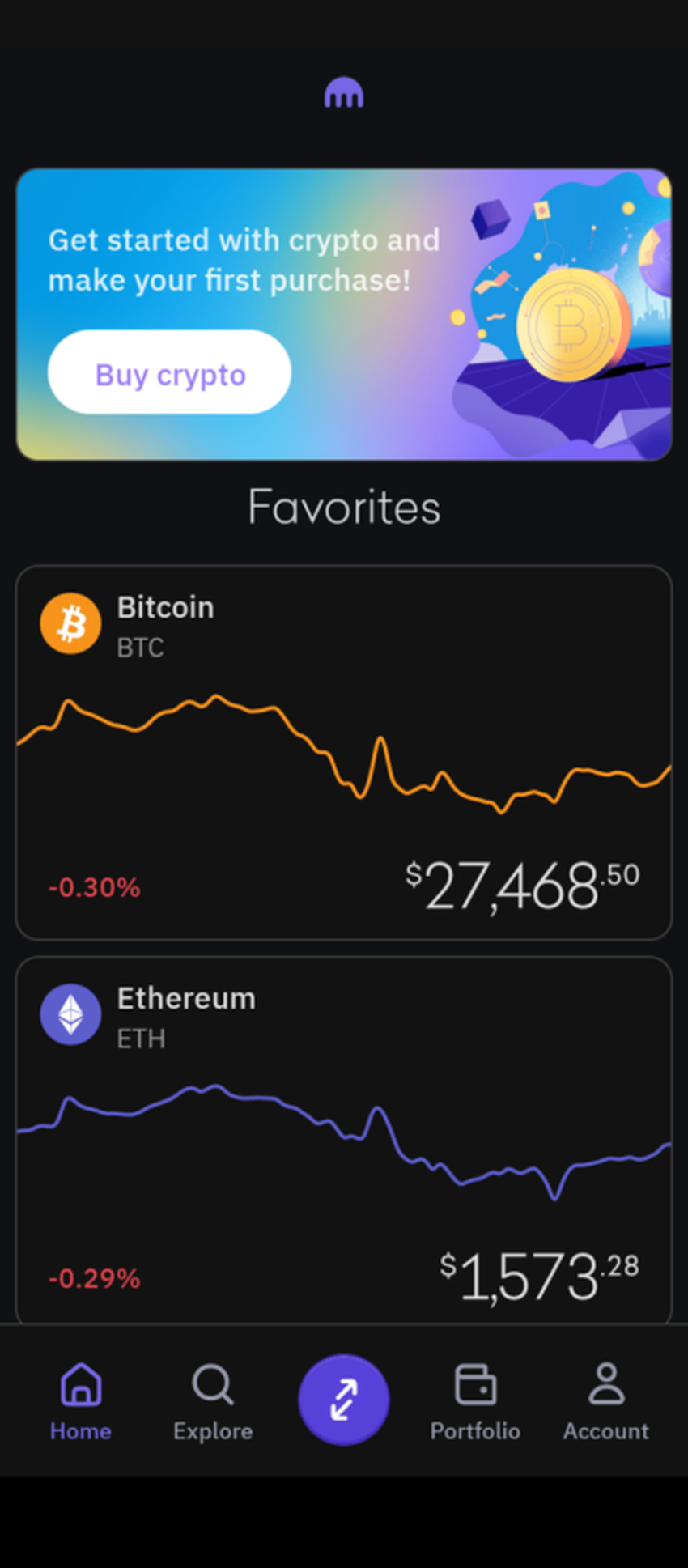
2. Secondly, select “Buy” and choose Bitcoin.

3. Select the amount you would like to purchase and press next.

4. Swipe the slider to the right to complete your purchase.

How to sell Bitcoin
Selling Bitcoin involves similar steps to buying:
- Access the “Sell” option in your exchange account.
- Choose BTC as the asset.
- Specify the amount and confirm the sale.
If you’ve accumulated Bitcoin and are looking to sell, exchanges like Binance and Coinbase provide options for standard selling and peer-to-peer (P2P) transactions.
Limit and market orders are available for selling, and platforms may support off-ramping BTC for fiat currencies or altcoins. P2P transactions offer a level of anonymity, while OTC markets accommodate bulk transactions.
1. Open the Kraken app, scroll down, and select “More.” Press “Sell” to continue.

2. Select Bitcoin to move on to the next step.
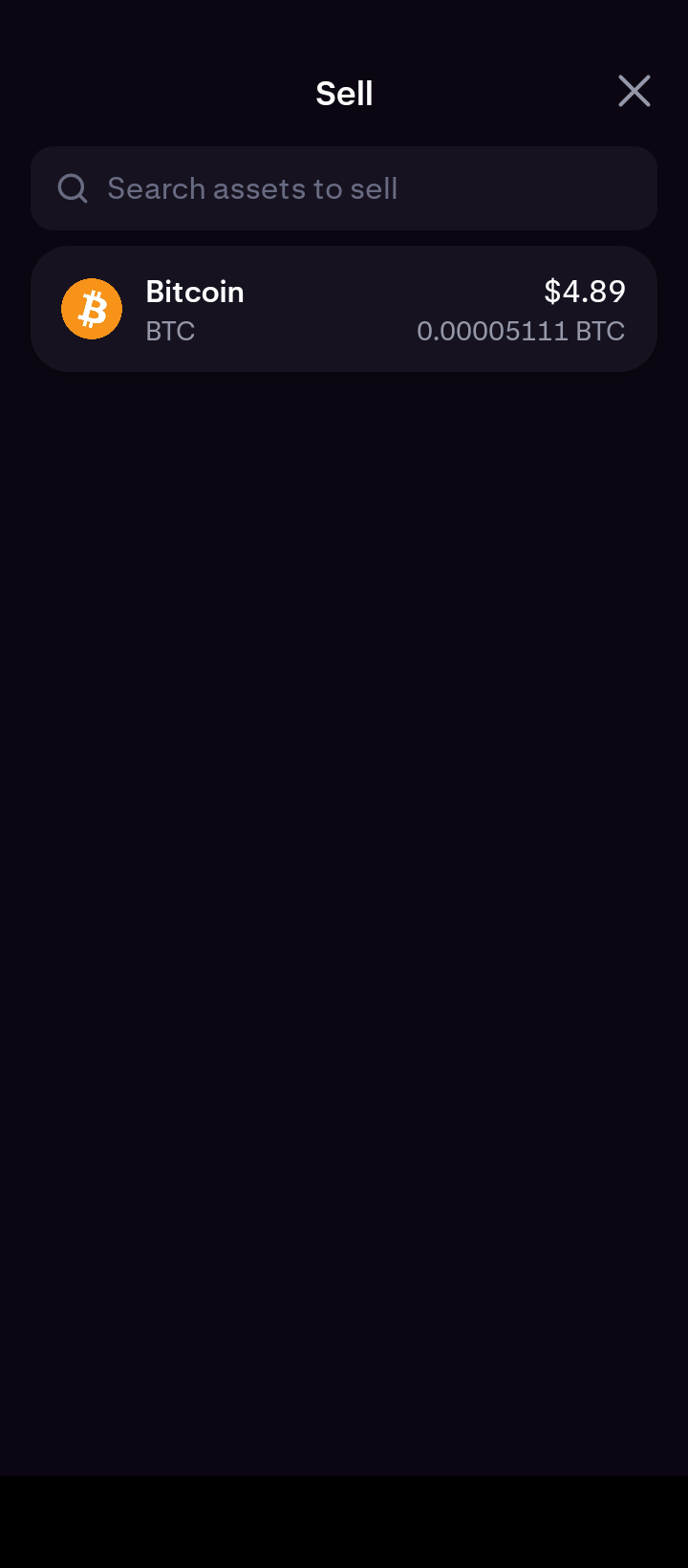
3. Select the amount of Bitcoin you would like to sell, then press “Next.”
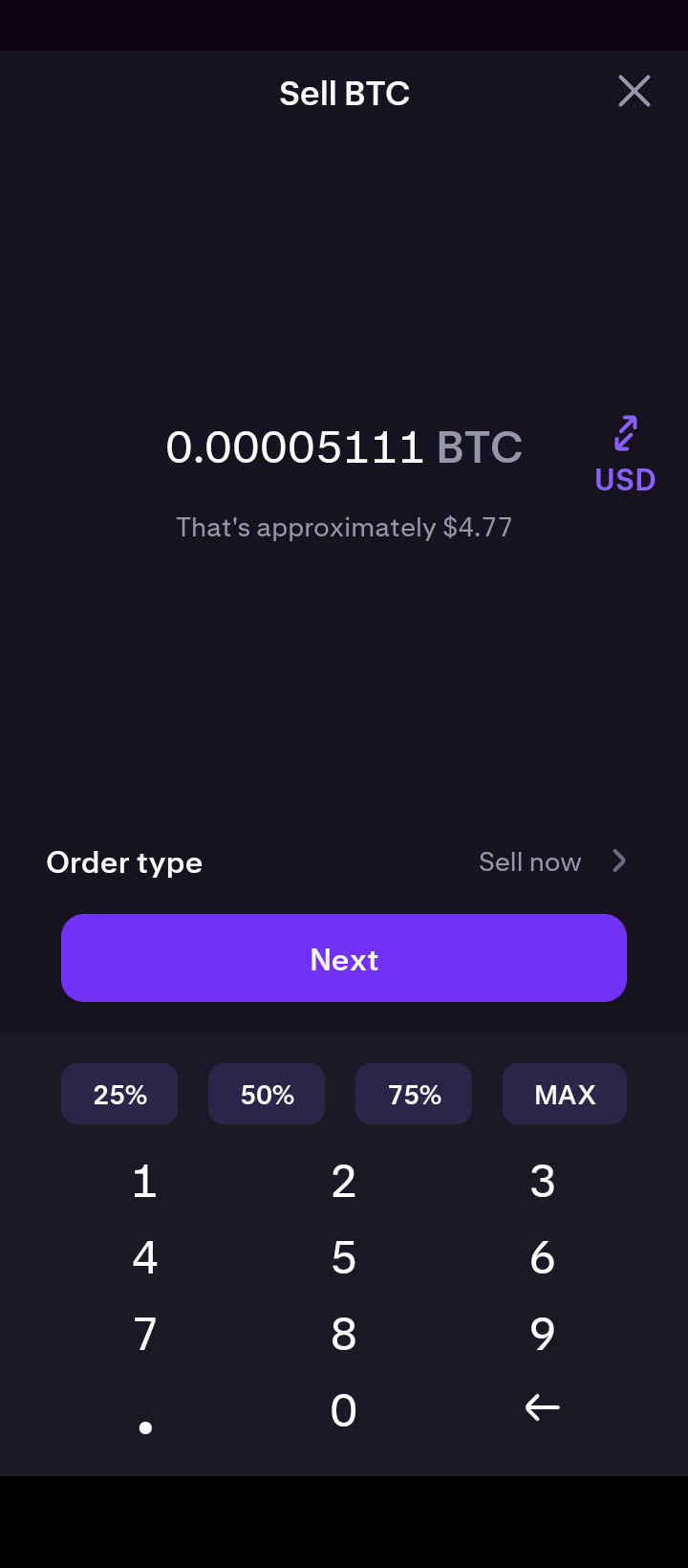
4. Lastly, make sure your order is correct, then swipe to confirm and complete your sell order.
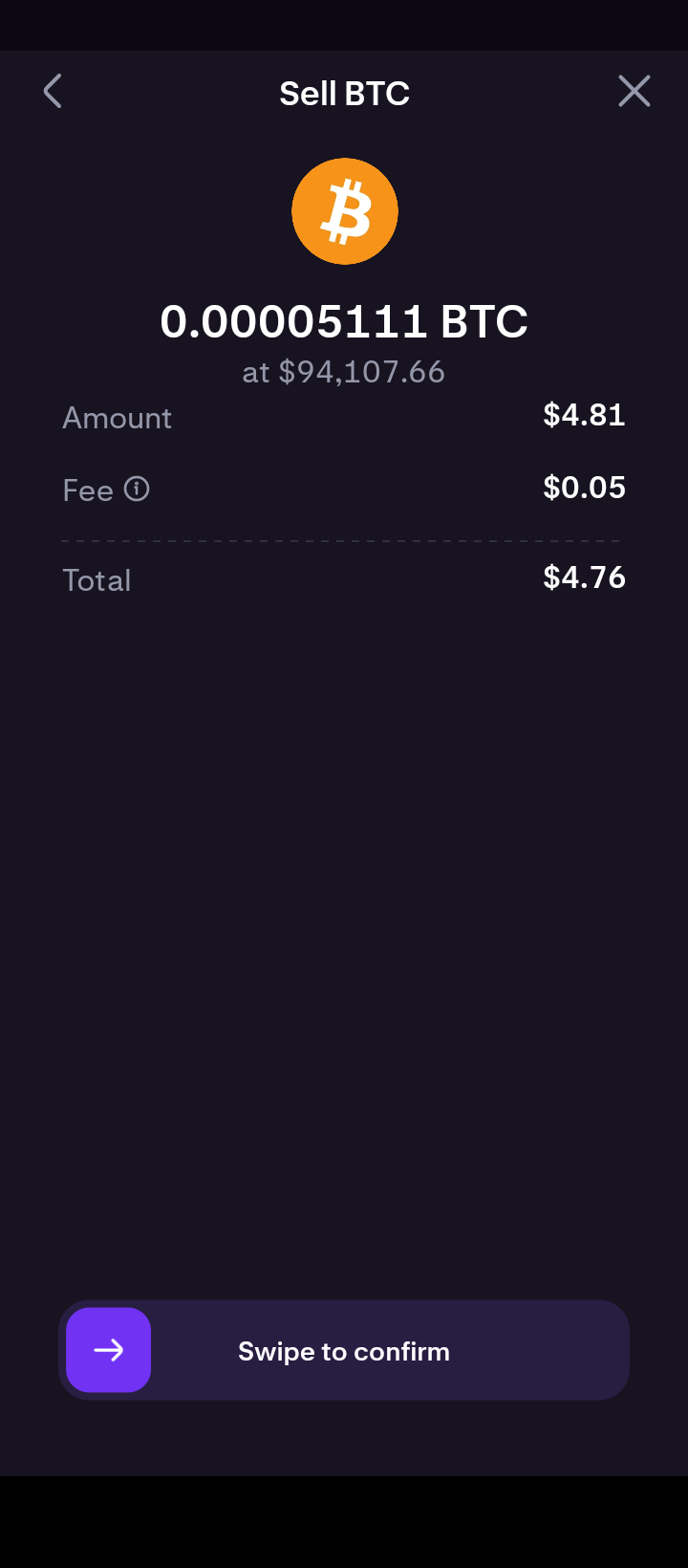
Where to buy Bitcoin
You can buy Bitcoin on pretty much any crypto exchange. Some of the most popular platforms for buying Bitcoin in 2025 include:
- Kraken: Kraken is known for high security and educational resources. It provides transparent fees and advanced features for new and experienced users alike.
- dYdX: A decentralized exchange that emphasizes autonomy, dYdX uses smart contracts and offers options for perpetual and margin trading.
- OKX: OKX simplifies Bitcoin purchases for users at all levels with its user-friendly app and responsive support
➤ We have highlighted these three exchanges particularly for their strong focus on security, transparent fee structures, and innovative features like decentralized trading and margin options. They serve a wide range of users, from beginners seeking simplicity to advanced traders requiring sophisticated tools.
Note that some users may also prefer alternative methods over exchanges, such as digital wallets or P2P platforms.
Buying BTC anonymously (without ID)
There are several ways to buy Bitcoin without disclosing your identity:
- Decentralized exchanges: Purchase BTC without the need for centralized verification.
- Mixers and tumblers: Obscure your public address by shuffling transactions.
- New email and VPN: Create an account with a new email and use a VPN for added privacy.
- Bitcoin ATMs: A convenient option, though they often have purchase caps and limited availability.
How to achieve anonymity with Bitcoin
Using Bitcoin anonymously goes beyond just buying it. For secure, trace-free transactions, you’ll want to cash out BTC without revealing identity:
- Limited KYC exchanges: Some exchanges offer limited cash-out options without full KYC.
- Bitcoin ATMs: Ideal for cashing out discreetly.
- Conversion to privacy coins: Swap BTC for privacy-focused coins like Monero (XMR) or Dash for enhanced anonymity.
Best payment methods to buy Bitcoin
Bitcoin purchases can be made with a wide range of payment methods. Here’s a look at each:
- Cash App: Load funds into Cash App and place market or limit orders to buy BTC. Recurring purchases are also available, set on daily, weekly, or fortnightly intervals.
- Credit cards: Many exchanges, including StormGain (5% fee) and Paybis (6.5% fee), allow credit card purchases. Binance supports credit card deposits with fees of around 2%.
- Apple Pay: Supported on platforms like Kraken and Coinbase, Apple Pay enables BTC purchases. MetaMask also supports Apple Pay for buying certain cryptocurrencies directly.
- Google Pay: Google Pay users can purchase BTC on compatible exchanges like Binance and Coinbase by linking a payment method, such as a bank account or card.
- Skrill: Skrill enables Bitcoin trading along with over 40 other digital assets. After setting up and funding your account, select “Crypto” to initiate a BTC purchase. Skrill also allows BTC transfers to external wallets.
Buy Bitcoin using other payment methods
Various third-party platforms provide app-friendly, easy methods for Bitcoin purchases:
- Revolut: U.K.-based fintech platform Revolut offers cryptocurrency services. After creating a Revolut account, fund it via bank transfer or card, go to the “Crypto” section, select “Buy” to purchase Bitcoin, and transfer BTC to an external wallet as needed.
- Stripe: Stripe enables Bitcoin purchases through exchanges like Bitstamp. Just create a Stripe account, link a bank for payments, and fund your Bitstamp account. Once funded, select BTC from the “Market” segment and complete the transaction.
- PayPal: PayPal allows U.S. users to purchase Bitcoin directly from the app. Choose “Crypto” from the home page and follow the prompts to buy BTC. Platforms like AvaTrade and Coinbase also support PayPal as a payment option.
- Bitcoin ATMs: Bitcoin ATMs, similar to traditional ATMs, disburse BTC instead of cash. After depositing fiat via card, input your wallet address, and complete the transaction. Popular Bitcoin ATMs include Pelicoin, Just Cash, and RockitCoin, offering easy, in-person BTC purchases.
What is Bitcoin?
Bitcoin, created in 2009, is the world’s first decentralized cryptocurrency. Unlike traditional currencies issued by central banks, Bitcoin operates independently of any governing body.
It uses blockchain technology, an immutable, decentralized ledger that records every transaction across the network. This system removes the need for intermediaries, such as banks, to facilitate transactions.
➤ Bitcoin is pseudonymous, meaning transactions are tied to wallet addresses rather than real-world identities, which ensures a degree of privacy to users.
With a fixed supply of 21 million coins, Bitcoin is deflationary by design, unlike fiat currencies, which can be printed indefinitely.
Bitcoin has become widely known as a “store of value” and is often compared to assets like gold due to its finite supply and decentralized nature. Its use as a medium of exchange continues to grow, with more merchants and financial platforms adopting Bitcoin payments.
Sponsored SponsoredWho invented Bitcoin?
In 2008, a whitepaper titled “Bitcoin: A Peer-to-Peer Electronic Cash System” was published by Satoshi Nakamoto — an anonymous individual or a group. While the whitepaper first introduced the concept of Bitcoin, the network officially came into existence in 2009.
➤ Over the years, Bitcoin’s value and recognition have grown exponentially, especially after pivotal moments like the first major BTC purchase in 2010, where Laszlo Hanyecz famously paid 10,000 BTC for two pizzas.
This event, now celebrated as Bitcoin Pizza Day on May 22, highlights Bitcoin’s evolving use as currency.

How Bitcoin works: the fundamentals
Bitcoin operates on a decentralized network called the blockchain, which functions as a public ledger. This ledger records all Bitcoin transactions in blocks, each cryptographically linked to the previous block, forming an unbreakable chain.
The system’s security and trust come from its decentralized structure, consensus mechanism, cryptographic algorithms, and peer-to-peer network.
Blockchain and decentralization
The Bitcoin blockchain is decentralized, meaning there’s no single governing entity. Instead, thousands of nodes (individual computers) maintain and verify the ledger worldwide.
Every node keeps a copy of the blockchain to ensure data accuracy and prevent tampering. This decentralized setup provides high security, as no single point of failure exists. This aspect makes blockchains resistant to censorship and fraud.
Transactions and cryptographic security
Bitcoin transactions involve transferring BTC from one address to another, which users create through public and private cryptographic keys.
➤ A public key generates a Bitcoin address, similar to a bank account number, while a private key acts as a password, securing transactions.
When a transaction is made, the sender signs it with their private key, which then undergoes verification by the network’s nodes. This cryptographic signature ensures the transaction’s authenticity without exposing private key details.
Mining and proof-of-work (PoW)
Bitcoin’s consensus mechanism, known as proof-of-work (PoW), is keyl to its decentralized validation process.
Miners — participants who solve complex cryptographic puzzles — compete to validate transactions and add blocks to the blockchain. The first miner to solve a puzzle confirms the block of transactions and earns a reward in BTC.
Each block added to the chain reinforces the immutability of previous blocks, as altering any block would require re-mining every subsequent block, which is computationally infeasible.
➤ The mining process ensures that all nodes reach a consensus on the blockchain’s current state. Doing so secures the network against attacks. The energy-intensive nature of PoW has led to discussions on sustainability, but it remains effective in maintaining network integrity.
Limited supply and halving mechanism
Bitcoin has a fixed supply of 21 million coins, enforced by its code. New Bitcoins are issued to miners as block rewards, but this reward halves approximately every four years in an event called “halving.”
Initially set at 50 BTC, the reward has gradually decreased, currently at 6.25 BTC per block as of 2024. The halving process controls inflation, which, in turn, ensures scarcity and contributes to Bitcoin’s perceived value as a digital asset.
Finality and security
Once confirmed, Bitcoin transactions become immutable, meaning they cannot be reversed or altered. This finality is a result of the blockchain structure and consensus, which makes Bitcoin a secure option for storing and transferring value.
The entire network relies on cryptographic algorithms and game-theoretic principles that incentivize honest behavior among miners and nodes.
So, to cut a long story short, Bitcoin operates through a combination of cryptographic security, decentralized consensus, and a structured issuance model. All of these combine to provide a secure and transparent digital currency system.
Understanding mining and transaction fees
While nodes provide the structure for Bitcoin’s network, miners supply the computing power to confirm transactions. As of post-2024 halving, miners now receive 3.125 BTC per confirmed block, down from the previous 6.25 BTC.
With no central authority, transaction fees and block rewards remain critical incentives for miners to maintain network security.
➤ Transaction fees vary based on network congestion and the desired confirmation speed. Wallets often include fee estimators, allowing users to gauge costs in real time.
Miners tend to prioritize higher-fee transactions to maximize earnings, especially with reduced block rewards following the 2024 halving. This shift may lead miners to focus even more on fee-intensive transactions to sustain profitability.
The Bitcoin Lightning Network
The Bitcoin Lightning Network is a scalability solution designed to make BTC transactions faster and cheaper. This protocol allows Bitcoin users to send and receive payments almost instantly, without delays from network congestion.
Benefits of the Lightning Network include:
- Instant transactions: Payments occur in seconds, ideal for everyday use.
- Low fees: Lightning transactions reduce costs significantly, especially compared to on-chain BTC transactions.
- Enhanced privacy: The network routes payments through private channels, providing added discretion.
To start using the Lightning Network for payments, you can consider wallets such as Joule or Spark, which support fast, efficient BTC transactions.
Bitcoin energy consumption
As of late October 2025, the Bitcoin network’s total electrical energy consumption is expected to be around the 172 TWh mark, which is still on the higher side. Recent shifts toward sustainability have led more miners to adopt water, wind, solar, and nuclear power. But, overall, the energy consumption by the network still remains high.
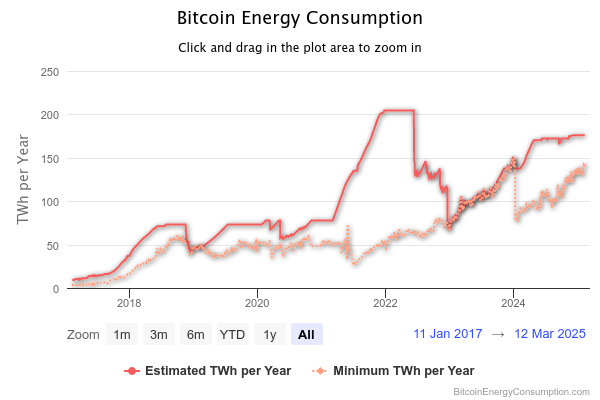
Bitcoin volatility
Anyone looking to buy Bitcoin safely should be mindful of volatility. But what causes Bitcoin’s volatility, and how does it impact price?
What causes Bitcoin volatility?
Despite being the first popular crypto and an asset with the most credibility in the crypto space, sentimental drivers can still push the cryptocurrency price higher or lower significantly.
However, BTC volatility isn’t driven solely by sentiment. Other factors include shifts in investor confidence, long-term holding patterns, and sell-offs by established holders. Mainstream adoption events, such as El Salvador’s acceptance of Bitcoin as legal tender, also play a role.
Social trends, media influence, market manipulation, and global economic conditions like inflation and interest rate hikes contribute further.
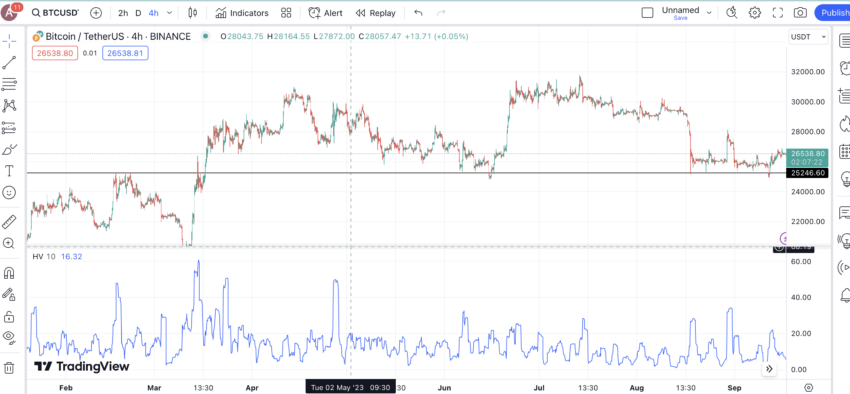
Regardless, every enlisted reason that might cause Bitcoin price volatility, somewhere, translates to the overall sentiments surrounding the crypto.
While you can check the historical volatility of Bitcoin using TradingView, the Bitcoin fear and greed index also gives a good indication of market sentiments.
Impact on BTC price
Bitcoin volatility can have a trend-specific impact on the price of Bitcoin. If you look at the historical volatility indicator and compare the same with the prices, you will notice that a drop in Bitcoin volatility often translates into higher price peaks.
Therefore, if you wish to buy Bitcoin, the volatility-price relation is something to consider.

What is a Satoshi?
As of late October 2024, Bitcoin is trading at around $70,000, which makes it costly for whole-coin transactions. Instead, users often transact with smaller Bitcoin fractions, where the Satoshi, Bitcoin’s smallest unit, is key.
One Bitcoin equals 100 million Satoshis, offering needed divisibility and flexibility, so users can buy or sell any value of BTC they choose.
Bitcoin vs. other PoW coins
Despite the highly competitive crypto space, Bitcoin remains unmatched in popularity due to its unique and decentralized nature. However, several popular PoW cryptocurrencies have also gained significant traction over the years.
Here’s how they compare:
Sponsored Sponsored1. Bitcoin vs. Dogecoin
| Feature | Bitcoin | Dogecoin |
| Launch date | January 3, 2009 | December 6, 2013 |
| Creator | Satoshi Nakamoto | Billy Markus, Jackson Palmer |
| Consensus mechanism | Proof-of-work (PoW) | Proof-of-work (PoW) |
| Block time | ~10 minutes | ~1 minute |
| Max supply | 21 million | Unlimited |
| Tansaction fees | High | Low |
| Primary use | Store of value | Tipping, small payments |
| Market cap rank | Top | Lower |
2. Bitcoin vs. Litecoin
| Feature | Bitcoin | Litecoin |
| Launch date | January 3, 2009 | October 7, 2011 |
| Creator | Satoshi Nakamoto | Charlie Lee |
| Consensus mechanism | Proof-of-work (PoW) | Proof-of-work (PoW) |
| Block time | ~10 minutes | ~2.5 minutes |
| Max supply | 21 million | 84 million |
| Transaction speed | Moderate | Faster |
| Transaction fees | High | Llow |
| Primary use | Store of value | Ppeer-to-peer payments |
3. Bitcoin vs. Bitcoin Cash
| Feature | Bitcoin | Bitcoin Cash |
| Launch date | January 3, 2009 | August 1, 2017 |
| Creator | Satoshi Nakamoto | forked by developers |
| Consensus mechanism | Proof-of-work (PoW) | Proof-of-work (PoW) |
| Block size | 1 MB | 32 MB |
| Transaction speed | Moderate | Faster |
| Transaction fees | High | Low |
| Primary use | Store of value | Daily transactions |
| Community focus | Decentralization | Scalability |
Is BTC a profitable investment in 2025?
Bitcoin has delivered impressive returns over the years. In April 2013, one BTC was priced at $135.30, soaring to nearly $69,000 by November 2021.
As of late October 2024, BTC is again hovering around $70,000, which highlights its long-term stability and growth potential.
In addition to these returns, buying BTC allows you to diversify with a relatively stable cryptocurrency, access high liquidity, and benefit from ongoing adoption and innovation.
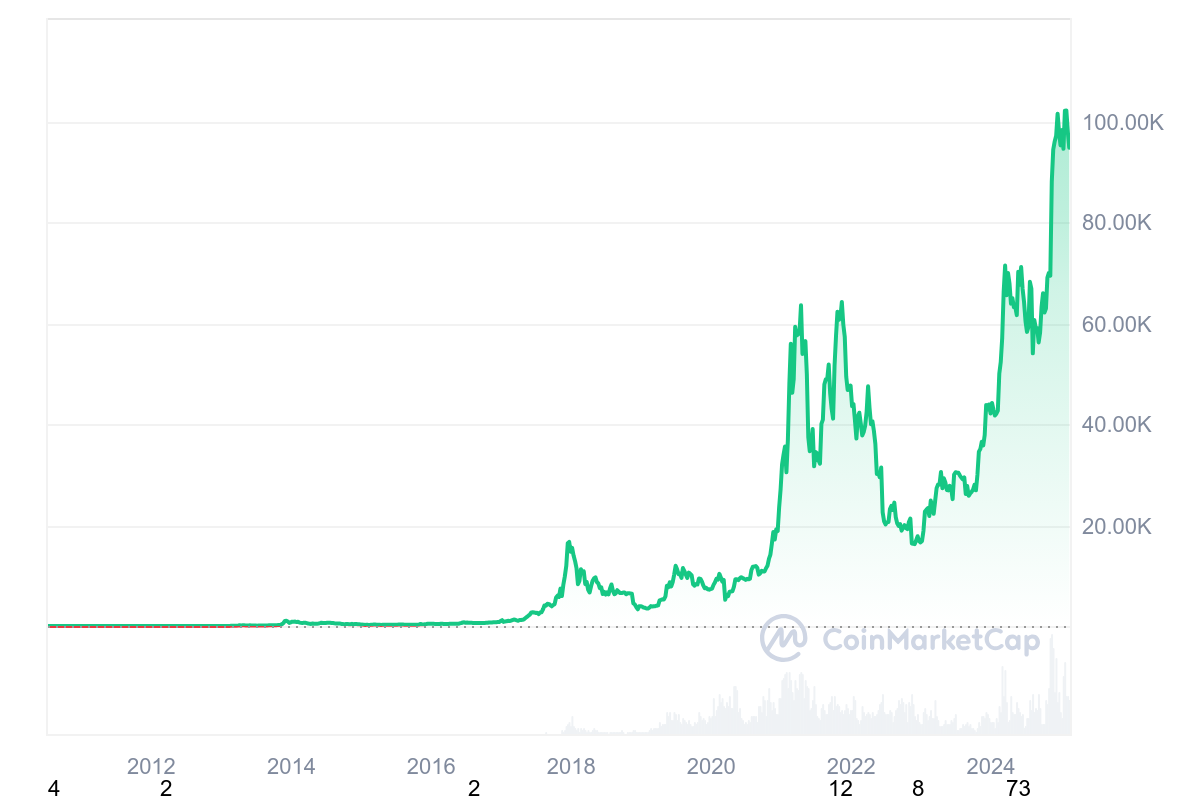
Understand the key Bitcoin metrics
As mentioned earlier, understanding BTC’s price moves can be a good way to analyze the entire crypto space. Also, unlike some of the lesser-known cryptocurrencies, which haven’t been around for long, Bitcoin has several specialized metrics that can help you understand the ecosystem better.
As a crypto beginner looking to buy Bitcoin to trade or invest, you should keep a close eye on Bitcoin halving cycles. Understanding the historical price moves in relation to the halving cycles can help you figure out general crypto investment strategies, as well as specific Bitcoin halving investment strategies.
Next comes the Bitcoin dominance chart that can help analyze the bullishness or bearishness associated with the altcoin space. As explained earlier, if the chart shows a dip while the price of BTC increases, the altcoin space might soon rally.
➤ Another Bitcoin-specific metric is the stock-to-flow model that hinges on the concept of a supply cap. This model ensures that the Bitcoin price peaks every time the scarcity narrative takes center stage, especially during the halving cycles. Understanding the scarcity and the bitcoin stock-to-flow model can, therefore, give traders an edge.
Finally, the Bitcoin rainbow chart is a metric or, rather, a tool useful to value-buying traders. This tool looks like a rainbow, with the structure divided into colored bands. The lowest band, or the blue band of the rainbow, is where the bearish trend takes center stage.
However, if the price moves up to the light blue space, you can consider value-buying opportunities. Similarly, Bitcoin price hovering within the dark red zone is certainly an overbought territory and prone to severe profit booking.
Another Bitcoin metric that tracks sentiments is the fear and greed index:
Investing in Bitcoin: long-term vs. short-term strategies
You can invest in Bitcoin with a long-term outlook or trade it based on short-term trends to capture price movements.
Beyond typical investing and trading, other proven ways to earn with Bitcoin include:
- Buying and holding (hodling) BTC for long-term gains
- Lending BTC to earn interest
- Setting up a lightning node, a rewarding option for those interested in Bitcoin’s payment infrastructure without direct ownership
BTC as a hedge against inflation?
For years, many Bitcoin advocates have promoted it as a “hedge against inflation.”
What does this mean?
Unlike fiat currencies, which central banks can print at will, Bitcoin has a fixed supply cap of 21 million BTC. This limited supply protects Bitcoin from the devaluation or inflation risks that affect traditional currencies.
Counterpoints to the hedge narrative
Some argue against Bitcoin as an inflation hedge, given its recent sideways price movement. Instead, a stronger case might be viewing Bitcoin as a guard against currency debasement — the gradual loss of fiat value over time.
The Bitcoin network and ecosystem is thriving
If you are looking to buy Bitcoin, we recommend reading this entire piece closely to gain a true perspective of the sheer size and importance of the ecosystem. From top-notch security, courtesy of nodes, to wrapped Bitcoin, a whole world of PoW miners and mining-specific services, the BTC ecosystem is a lot more than simply trading.
Instead, Bitcoin also has a separate identity as a peer-to-peer digital currency, a concept that is slowly gaining traction across the globe. Despite occasional bear markets, it is of little surprise that so many people — from all walks of life — remain eager to buy BTC.
Disclaimer: This content is for informational purposes only and does not constitute investment advice. Cryptocurrency markets are highly volatile, and investing in them involves significant risk. Always conduct your own research and consult a qualified financial expert before making any investment decisions.

